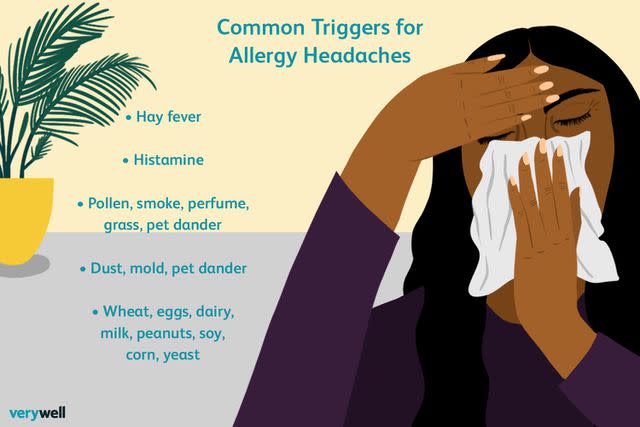Can Allergies Cause Headaches?

Jamie Grill / Getty Images
Medically reviewed by Jurairat J. Molina, MD
An allergy headache occurs when allergy symptoms trigger a headache. The headache may be directly triggered by sinus pain, resulting in a sinus headache. It could also be indirectly triggered by a nervous system reaction to the allergy, causing a migraine.
Not everyone who has allergies will experience headaches. There is currently no universally accepted definition as to what constitutes an allergy headache.
If your headaches are frequent, persistent, or severe, it's important to see your healthcare provider. They can help you determine what's causing them so you can get the right treatment.
This article explores the symptoms and common triggers for allergy headaches as well as the treatment options that may bring relief.
Symptoms of an Allergy Headache
An allergy headache is a general term that describes any head pain that results from an allergy. The pain may be directly due to allergy symptoms, or the allergy symptoms may trigger pain in people with chronic migraines. Distinguishing one from the other can be difficult.
Sinus Headaches
Sinus headaches involve pain in the sinus area of the face, including the cheeks and forehead. These headaches commonly occur as a result of allergic rhinitis, also known as hay fever. Seasonal allergic rhinitis is most often caused by tree or grass pollens. These pollens are carried in the air at different times of the year.
Under normal circumstances, the sinuses are open cavities that allow you to breathe air and drain mucus. With allergic rhinitis, the overreaction of the immune system causes the passages to swell. This leads to sinusitis (sinus inflammation) and the development of sinus pain and pressure.
Symptoms of a sinus headache can range from mild to severe and typically include:
Pain, pressure, and fullness between the eyes and/or behind the cheeks or forehead
An aching sensation in the upper teeth or jaw
Worsening pain when you lie down or bend over
Stuffy nose and trouble breathing
Fatigue
Migraine Headaches
An allergy headache can sometimes have little to do with sinus inflammation. Rather, the pain may be caused by any number of environmental factors that are known to trigger migraines.
Migraines are more than just "really bad headaches." They are a recurrent and sometimes debilitating neurological disease that can cause a variety of symptoms, including:
A visual disturbance called an aura that manifests with bright lights, flashing lights, or shapes
A pulsing, throbbing pain usually on one side of the head
Extreme sensitivity to light, sound, or smells
Nausea and vomiting
What Does an Allergy Headache Feel Like?
Allergies can cause two types of headaches: migraine and sinus headaches. Migraine headaches tend to cause pulsating or pounding pain on side of the head, often with nausea or vomiting. Sinus headaches occur in the middle of the face behind the eyes or forehead, typically with nasal congestion.
What Causes an Allergy Headache?
The cause of an allergy headache can vary based on whether allergic rhinitis or a migraine is involved. Because the causes can overlap, diagnosing the underlying condition can take time.

Verywell / Danie Drankwalter
Sinus Headaches
Sinus headaches caused by allergic rhinitis are the result of the overreaction of the immune system. This overreaction causes inflammation in the sinuses and nasal passages as well as the eyes, throat, and sometimes the lungs.
Allergies are ultimately the result of an inappropriate immune response to an otherwise harmless substance known as an allergen. When this occurs, the immune system will release a substance called histamine that triggers inflammation in different parts of the body.
When an allergen such as pollen is respiratory, allergic rhinitis can occur.
Allergens commonly associated with allergic rhinitis include:
Tree pollens
Grass pollens
Mold
Pet dander
Dust mites
Tobacco smoke
The underlying cause of allergic rhinitis is unknown, but it is thought that genetics plays a role.
In addition, infants who get eczema may experience a phenomenon known as atopic march that can lead to a cascade of allergy-related disorders, including food allergies, asthma, and allergic rhinitis.
Related: What Is Atopy and Atopic Disease?
Migraine Headaches
The underlying causes of migraines are unknown. However, they are believed to be the result of a combination of genetic and environmental factors. This is evidenced in part by studies in which 30% to 60% of twins or first-degree family members will have migraines.
Migraines can be triggered by many different things, including environmental allergies like hay fever.
Other possible triggers for migraine headaches include:
Food allergies or intolerances
Tobacco smoke
Strong smells
Fatigue
Stress
Hunger
Alcohol
Changes in the weather
Hormonal changes, including menstruation
How Do I Know if Allergies Are Causing my Headache?
Allergy headaches tend to be seasonal and occur when pollen counts are high. Depending on what you are allergic to (for example, tree pollen or ragweed), the timing of your headaches will correspond to when the plants are in bloom.
Related: Seasonal Allergies and How to Treat Them
How to Treat Allergy Headaches
The treatment of allergy headaches differs based on whether the underlying cause is allergic rhinitis or a migraine.
Sinus Headaches
Sinus headaches are treated by reducing the effects of histamine while managing the pain and congestion. Treatment options include:
Over-the-counter painkillers: These include Tylenol (acetaminophen) and nonsteroidal anti-inflammatory drugs like Advil (ibuprofen) or Aleve (naproxen).
Oral antihistamines: These include non-drowsy formulations like Claritin (loratadine) and older formulations like Benadryl (diphenhydramine) that can help you sleep comfortably at night.
Antihistamine nasal sprays: These nasal sprays work locally to counteract the effects of histamine in the nose.
Oral decongestants: These include pseudoephedrine, a drug that can reduce the swelling of blood vessels throughout the body, including those in the nose.
Decongestant nasal sprays: These work by directly shrinking swollen blood vessels in the nose.
Steroid nasal sprays: These temper inflammatory substances in the nasal passages. While effective, they can take several days to work.
Nasal irrigation: This involves manually flushing the nasal passages with a saline solution or purified water (either with a bulb syringe, spray bottle, or neti pot).
Related: How Headaches Are Treated
Migraine Headaches
Migraines are often not treated the same way as sinus headaches, which is why it is important to differentiate the two before treatment.
Treatment options for migraines include:
Over-the-counter painkillers: The same drugs used to treat sinus headaches may be appropriate for mild to moderate migraines.
Triptans: These are a class of drugs used in the first-line treatment of moderate to severe migraines. They include Axert (almotriptan), Relpax (eletriptan), and Frova (frovatriptan).
Dopamine agonist antiemetics: These second-line drugs, which treat migraines and accompanying nausea, include Haldol (haloperidol) and Reglan (metoclopramide).
Dihydroergotamine (DHE): This is an injectable or nasal drug commonly used when migraines fail to respond to other drug treatments.
Corticosteroids: These anti-inflammatory drugs are delivered by injection to reduce the severity and recurrence of migraines in emergency situations. Dexamethasone is one of the most common options.
Related: How Migraines Are Treated
Are There Tests to Diagnose the Cause of Allergy Headaches?
If you have an allergy headache, the first thing your healthcare provider will want to do is determine if allergic rhinitis or a migraine is at the heart of the problem.
Sinus Headaches
Allergic rhinitis is diagnosed based on a review of your symptoms and medical history. If your symptoms are severe, you may be referred to a specialist known as an allergist who can perform tests to identify the different allergens you are reactive to.
The allergy tests include:
Skin-prick tests: This is the primary form of testing in which tiny amounts of common allergens, such as pollen or pet dander, are introduced under the skin to see if you have a reaction.
Allergen-specific IgE tests: These are blood tests that look for immune proteins, called antibodies, that are produced by the immune system in response to specific allergens.
Related: How Headaches Are Diagnosed
Migraine Headaches
There are no specific tests used to diagnose migraines. Migraines are diagnosed based on a pattern of recurring headaches with associated symptoms, such as auras and nausea or vomiting. The process often takes time, in part to exclude all other possible causes.
For an accurate diagnosis, you may be referred to a specialist known as a neurologist who may perform tests to rule out other causes. This may include undergoing a computed tomography (CT) scan or magnetic resonance imaging (MRI) scan of the brain.
Related: How Migraines Are Diagnosed
When to See a Healthcare Provider
If you have any of the following symptoms, call your healthcare provider or go to the emergency room right away. These can be signs of a more serious health condition:
An excruciating headache
Nausea and vomiting occurring with your headache
Loss of consciousness or vision
If you are experiencing headaches frequently or have one that won't resolve, consult your healthcare provider as soon as possible.
If you have questions or concerns about medications you are using to treat headaches, discuss them during your appointment. Your healthcare provider can offer additional information and instructions on how to treat your headaches safely.
Summary
Allergies can sometimes cause headaches. This may be due to the buildup of sinus pressure caused by allergic rhinitis (hay fever) or occur when an environmental trigger such as an allergy triggers a migraine.
It is important to differentiate between a sinus headache and a migraine headache since the treatment for each is different. Sinus headaches typically cause pain behind the eyes accompanied by nasal congestion. Migraines typically cause throbbing pain on one side of the head, often with nausea or vomiting.
If you have been unable to find relief from chronic, recurring, or seasonal headaches, speak with your healthcare provider. They can help you determine whether an allergist or neurologist is the specialist you need. Sometimes it takes both.

